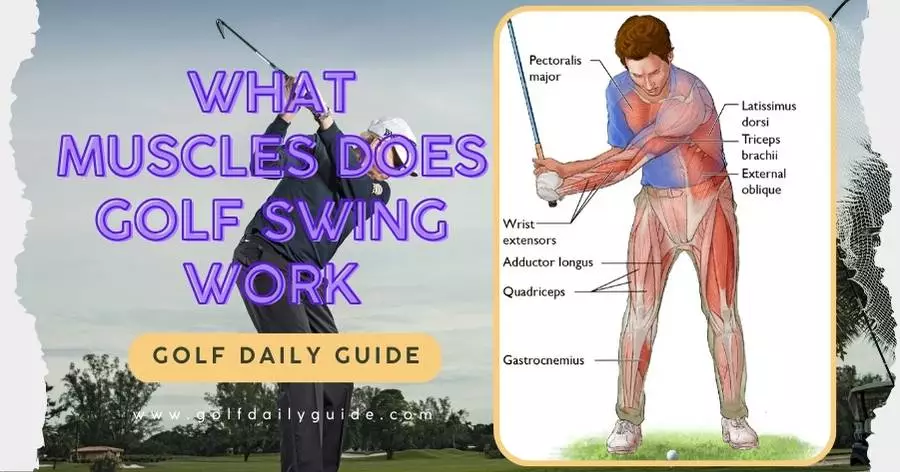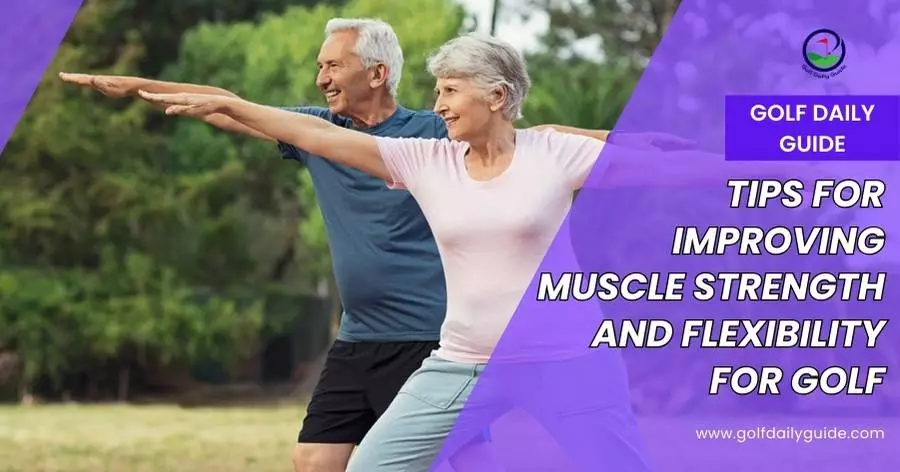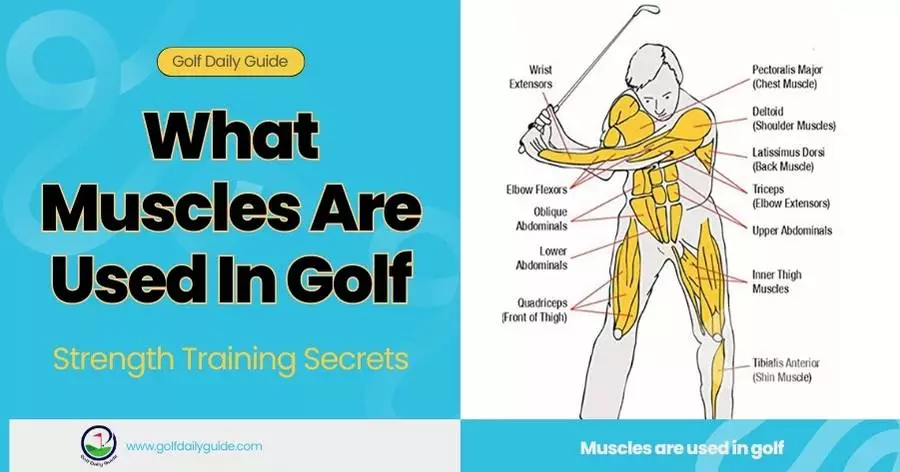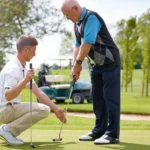Golf is a popular sport people of all ages and skill levels enjoy. Whether you’re a seasoned pro or a beginner, golf can be a fun and challenging way to spend your time. But have you ever wondered exactly What muscles are used in golf?
Ever wondered what’s really going on with your muscles when you take that swing on the green? Well, get ready for a mini adventure into the muscle world of golf – it’s more exciting than you might think!
Does golf build muscle?
Golf is an excellent sport that people of all ages can enjoy. While it may not seem the most physically demanding activity, many golfers wonder if it can help build muscle.
The answer is yes – golf can work various muscles in your body, and in this blog post, I’ll explore which muscles golf works and how it can help build muscle.
1. Upper Body Muscles
Golf involves a lot of swinging, so your upper body muscles are utilized the most. The main muscles that golf works in your upper body are your shoulders, triceps, biceps, and forearms.
The shoulder muscles, in particular, are heavily involved in the golf swing, providing the power and rotation needed to hit the ball.
2. Core Muscles
Your core muscles are also engaged when playing golf, as they help stabilize your body during the swing. The core muscles include your abs, obliques, and lower back muscles.
You can develop a stronger core and improve your balance and stability by engaging these muscles during your swing.
3. Leg Muscles
Although golf is primarily an upper-body sport, your leg muscles are still used when walking the course or taking a swing.
The main leg muscles that are worked during golf are your quads, hamstrings, and calves. Walking the course can also help improve your cardiovascular fitness, essential for overall health.
In conclusion, golf can help build muscle. You can develop a stronger and more balanced physique by engaging your upper body, core, and leg muscles. Plus, playing golf is a fun way to stay active and healthy. So, if you’re looking for a new sport, give golf a shot!
What muscles should be sore after golf?
Golf is a sport that requires a lot of physical effort, and it can be a great workout for your entire body. But have you ever wondered which muscles should be sore after a round of golf?
Firstly, let’s talk about the muscles in your arms. Your forearms, biceps, and triceps are all used extensively when swinging a golf club.
Your forearms are responsible for keeping your wrists firm during your swing, while your biceps and triceps work together to give power to your swing.
If you feel soreness in these muscles after a round of golf, it’s likely because you’ve been using them to generate power in your swing.
Next, let’s move on to the muscles in your back. Your upper and lower back muscles are crucial for maintaining good posture throughout your swing.
Your upper back muscles are also used when rotating your torso during your swing. If you’re feeling soreness in your back after golf, it’s likely because you’ve been using these muscles to maintain good posture and generate power in your swing.
Lastly, after a round of golf, you should expect to feel soreness in these muscles, but if you experience any pain, you should seek medical attention.

What muscles does golf swing work?
Are you new to golf and wondering what muscles it works? Or are you a seasoned golfer looking to understand the body mechanics behind a perfect swing?
Either way, you’ve come to the right place. Let’s dive in and explore which muscles are used in a golf swing.
Starting from the ground up, your feet and legs are crucial for generating power and stability during the swing.
The quadriceps, hamstrings, glutes, and calves all work together to help you maintain balance and generate force as you shift your weight from your back to your front foot during the swing.
Moving up the body, the core muscles play a crucial role in maintaining proper posture and generating rotational force.
The abdominals, obliques, and lower back muscles are all activated during a golf swing, helping to stabilise the spine and transfer energy from the lower body to the upper body.
Finally, the muscles in your arms and hands are critical for delivering the clubhead to the ball quickly and accurately.
So, the next time you’re out on the course, pay attention to how your body moves and feel the muscles working together to create the perfect shot.
How many muscles are used in a golf swing?
Golf is a sport that requires precision, skill, and a lot of muscles. Many people underestimate golf’s physical demands, assuming it’s a leisurely game. However, golfers use a variety of muscles to execute a successful swing.
The key muscles involved in a golf swing are the core, glutes, quadriceps, hamstrings, hips, back, and shoulder muscles:
1. Core Muscles:
Your core muscles are the foundation of your golf swing. They provide stability and balance during your swing. The core muscles include your abs, obliques, and lower back muscles.
2. Glutes:
Your glutes are also essential in a golf swing. They provide power and stability during the backswing and downswing.
3. Quadriceps and Hamstrings:
Your quadriceps and hamstrings generate power during the downswing. They work together to create a smooth and powerful swing.
4. Hips:
Your hip muscles are critical in a golf swing. They help generate power and speed during the downswing and follow-through. The hips also help to rotate the body during the swing.
5. Back Muscles:
Your back muscles are responsible for maintaining the correct posture during the swing. They also help to generate power and speed during the downswing.
6. Shoulder Muscles:
Your shoulder muscles are crucial in a golf swing. They help to control the clubface and generate power and speed during the downswing and follow-through.
Golf can be an excellent workout for your body, using multiple muscle groups simultaneously. Regularly playing golf can improve your overall fitness level, strengthen your muscles, and improve your balance and coordination.
So, the next time you hit the golf course, remember that you’re not just having fun but also getting a great workout.
Tips for improving muscle strength and flexibility for golf
Golf is a sport that requires a lot of physical strength and flexibility. It’s not just about hitting a ball with a club, it’s about having the physical ability to do so effectively.
You need to work on your muscle strength and flexibility to improve your golf game. In this blog post, we’ll share some tips on how to do just that. What muscles does golf work?
Before we get into the tips, let’s first talk about what muscles golf works. Golf is a sport that requires a lot of different muscles to work together to achieve a good swing.

Some of the main muscles used in golf include:
1. Core muscles:
Your abdomen and lower back muscles are essential for a good golf swing. They help stabilise your body and provide the power to generate a strong swing.
2. Leg muscles:
Your legs are also important in a golf swing. The muscles in your thighs and glutes help to transfer power from your lower body to your upper body.
3. Shoulder muscles:
Your shoulders rotate your arms and club during the swing. The shoulders and upper back muscles are crucial for generating power and control in your swing.
4. Forearm muscles:
Your forearms are involved in the grip and rotation of the club during the swing. Strengthening these muscles can help improve your grip and overall swing.
Now that we know what muscles are involved in golf, let’s move on to some tips for improving your strength and flexibility:
1. Stretch regularly
Stretching is important for maintaining flexibility and preventing injury. Before playing golf, stretch your core, leg, shoulder, and forearm muscles. Hold each stretch for 20-30 seconds and repeat on both sides.
2. Do strength training exercises
Strength training exercises can help improve muscle strength and power. Focus on exercises that target your core, legs, shoulders, and forearms. Some examples include planks, squats, lunges, shoulder presses, and wrist curls.
3. Practice your swing
Practicing your swing is the best way to improve your golf game. Use proper form and technique to avoid injury and maximize your power. Focus on using your core and leg muscles to generate power and your shoulder and forearm muscles to control the club.
4. Use resistance bands
Resistance bands are a great way to improve muscle strength and flexibility. They can target specific muscle groups and help improve your golf swing. Incorporate resistance band exercises into your strength training routine for maximum benefit.
5. Stay hydrated
Staying hydrated is important for maintaining muscle function and preventing injury. Ensure you drink plenty of water before, during, and after your golf game to stay hydrated.
Improving your muscle strength and flexibility is essential for improving your golf game. By following these tips, you can strengthen the muscles involved in golf and improve your swing.
Dedication and hard work can make you a better golfer and enjoy the sport even more.
Related Post
Can A Golf Ball Kill You
How to Clean Leather Golf Gloves
What is a reverse shotgun start in golf
What Time is Twilight Golf
Why golf has 18 holes
Final Thought for What muscles are used in golf
In conclusion, the golf swing works various muscles throughout the body, including the core, shoulders, arms, and legs.
Understanding the specific muscles involved in the golf swing can help golfers tailor their strength and flexibility training to improve their performance on the course.
By targeting these muscle groups through exercise and stretching routines, golfers can enhance their power, accuracy, and endurance while minimizing the risk of injury.
So whether you’re a beginner looking to build a strong foundation or an experienced player aiming to refine your technique, incorporating targeted workouts into your routine can make a significant difference in your game.
So, take advantage of this knowledge and start incorporating specific exercises into your training regimen to take your golf game to the next level!












